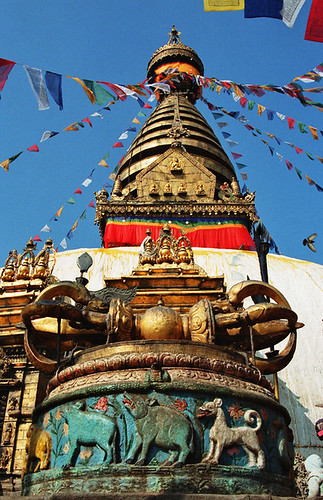
The natural splendor of Nepal and the intense religiosity of its people are caught in a trip to the Himalayas Kathmandu.
According to legend, this ancient kingdom born of a lotus flower floating, solitary, in the lake which once occupied the valley of Kathmandu. Today, Nepal enchants with its ancient culture, with the mysticism that permeates the daily lives of its inhabitants, with its fertile valleys and majestic mountains that are a stairway to heaven of all Eastern religions and beliefs.
There are no more traces of the hippies who made Nepal a place of worship, crazy back in the ’60s, and settled in this corner of Asia within the international tourism map. Young foreigners who used to pass through the narrow winding streets of Kathmandu, the capital of this land of harmony and meditation, have now been replaced by more conventional tourists who experience a fascination for the beauty and history of this country, which survive legends such as the Yeti, the abominable snowman, and Kumari, the goddess-girl girls chosen from the Sakya caste.
Wonders of Kathmandu:
An unforgettable place in Kathmandu’s Durbar Square. Their temples carved wooden wonders create a bunch of forms populated by beings that catch your eye unthought of Western travelers. Among them are the Taleju, built in 1549, the Hanuman Dhoka, the old royal palace, the Kashtha Mandap, made with wood from a tree, the Ashok Binayak, built to honor the elephant god and Jagannath, famous for its carvings erotic motifs. Around the square are dozens of craft shops and restaurants very acceptable to prove popular in some of the delicacies that make up the Nepalese cuisine, which is very similar to India. The basis of almost any meal is rice, which is combined with different kinds of curries and steamed vegetables, as well as rarities like yak meat.
The spell that produces Nepal begins, without a doubt, wandering at random through the winding streets of the capital and areas that are the famous stupas like Swayambu, decorated with giant eyes that evoke the look of the Buddha. Every day, the believers in the city (which is often) gather outside the spaces of the gods appear to hope that their beloved deities and bless, meanwhile ecstatic sing in front of images of the Hindu pantheon: Krishna, Shiva, Vishnu or Ganesha.

Although religion and mysticism are the most amazing of a visit to Nepal, the options go far beyond the temples and popular rites. With its great natural beauty, the Nepalese territory is ideal for trekking tours and bike rides through the jungle or climbing any mountains that make up the Himalayan.
Chitwan Park:
Nepal preserves the beauty of old buildings and the magic of the markets where vendors and passers go from one side to another exchange from high mountain flowers to yarn shawls so fine that go through the circumference of a ring. Both the capital of the kingdom and the other small cities, now have five-star hotels, many of them for climbers who will challenge the snow and the mountain passes, or go with backpacks on their shoulders and small valleys towns.
Beyond Kathmandu are the fields and virgin forests as Chitwan Park in the Terai. That region, full of bamboo forests and rice paddies, protects rhinoceros horn, various kinds of crocodiles and Bengal tigers. It also has beautiful landscapes formed by meandering rivers, cultivated fields and the majestic silhouette of peaks such as Everest and Annapurna, which can be observed from the air through a one-hour flight on small planes.
Sagarmartha Nature Reserve:
For its part, Sagarmartha Nature Reserve (declared World Heritage by UNESCO) is the gateway to Tibet, Bhutan and Sikkim, and Religious sites where you can make retreats. There you can witness unforgettable ceremonies at shrines where many monks, accompanied by children to religious candidates remain in the lotus position, repeating a prayer tinged with the sharp ringing of a bell or a gong that breaks the monotonous sound of prayer or mantra.

Another place to know is the Pokhara Valley. We suggest a visit. From here, trips to the Annapurna massif, and also towards the town of Namche Bazaar, known as the capital of the Sherpas, and Kirtipur, a small and charming city famous for the ancient tradition of weaving and Tribhuvan University.
Territory enigmatic roof of the world, tourists will find in Nepal not only a sweeping landscape and exotic culture, but a different way of living life.
In the realm of Shangri-la, the smiles are smooth and regular. And to visit is essential to know to use the word Namaste, which means «welcome», «Goodbye» and «thank you», a beautiful word is said with palms together in the center of the chest and bowing his head like a bow.
Finally we will tell you that the best times to travel are October to November and February to April.
Bon Voyage!
Leave a Reply
You must be logged in to post a comment.
Recent Comments